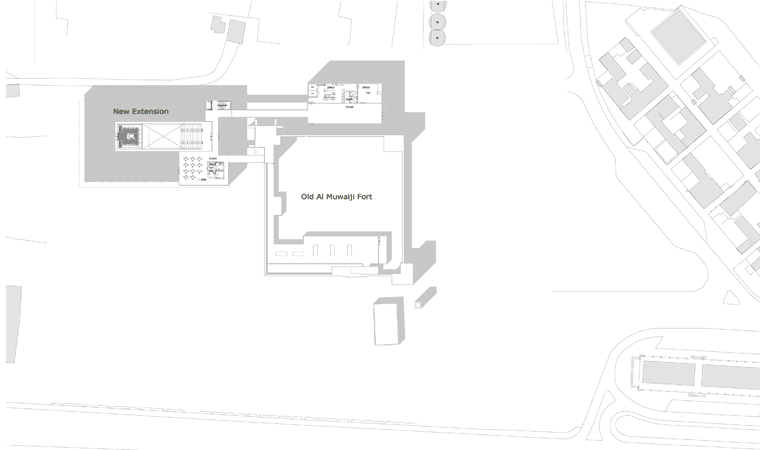Qasr Al Muwaiji, Greening an Oasis
Concept to Construction
The Qasr Al Muwaiji Fort is a historic site of great importance within the city of Al Ain. The new use as a museum incorporates the Fort into the living structure of the city, preserves it as part of al Ain’s architectural heritage and guarantees the site’s long-term future.
Author(s)
Machado Silvetti
Published
December, 2015
Tags
Qasr al Muwaiji, Sustainability
Historic Site
The site, which is developed as the Gulf Research and Exhibition Center dedicated to His Highness Sheikh Khalifa bin Zayaed and provides access to collections related to Gulf History has 35,000m2 (350 acres) of surrounding palm grove landscaped into a public garden.
The outdoor extension of the Center carries as much history as its indoor spaces and reflects the inspiration of the traditional context.
The landscape surrounding the Fort preserves a unique social aspect of how the Fort was used. The indigenous practice of using the landscape as an open “majlis”, or social gathering area has served an important heritage to communicate and preserve. These informal social gatherings often took place outside of the Fort, under the shade of a tree or up against a wall. This programmatic use became the impetus for the design of the landscape around the fort - the point of arrival before entry.
Vernacular Systems
A close analysis of the traditional constructions and landscape practices revealed a variety of defining characteristics. Geometrical shapes of the man-made environment predominate due to the basically flat topography. With limited construction means and for practicality purposes, the use of repetitive grids is frequently found in the arcades, openings, crenellations, tree pits and passages. This became the organizing principals behind the landscape design.
In the Arabian Peninsula, people had to depend upon irrigation for existence. Civilization has existed sole because of the art and science of irrigation. A Falaj system would have been the major source of bringing water to these arid zones from distant lands. It was a highly engineered procedure of tapping shallow underground by way of man-made, subterranean channels to the farming districts for irrigating purposes. Many such Falaj are still in use in Al Ain as well as other parts of the world today.
From a hydrological perspective, a Falaj consists of two parts. The upper part containing the tunnel lies under the groundwater surface. This part of the Falaj works as a horizontal well, collecting water though porous media. The lower part of the Falaj is mainly a channel above groundwater level. The Falaj channel conveys the water to the ground surface. The water is then applied to the trees and plants by flooding. Basin flooding was the most common practice.
The basin method of flooding is frequently used to date to irrigate orchards. On some farms, basins are made for each tree, but under favorable conditions of soil and surface slope from two to five percent, mature trees are included in one basin.
With an approach that is sympathetic and respectful of the history and architecture of the Old Fort and its surrounding, the landscape design proposes to preserve the idea of a serene and bucolic grove of date palms which not only offers poetic transition from the activity of the surrounding modern city but serves as a camouflage screen on which the design of the new architectural extension depends. The design adopts the same components and characteristics of the traditional architectural language in a new interpretation that responds to the needs of the new program and the adaptive reuse. By reintroducing the traditional landscape practices and initiating visitors on the Falaj irrigation system, different layers of plantation create a micro-climate and different sunlight intensity, shade and temperature.
Related Content
-
The adaptive reuse and substantial addition to Qasr Al Muwaiji includes a permanent exhibition located within the refurbished fort that culminates in a tour of the original rooms of the historic Palace. Read more about the full scope of the project here.
-
The story behind the design and development of, Qasr Al Muwaiji, a contemporary exhibition pavilion within a restored historic desert fort. Read more
-
Part I of Jeffry Burchard and Patrick Ruggiero's interview with Jorge Silvetti discussing the office’s approach to cultural heritage. Read here
-
Part II of Jeffry Burchard and Patrick Ruggiero's discussion with Jorge Silvetti on the firm’s approach to cultural heritage. Read more
-




